
Snapshot No. 650-654
654. Muku
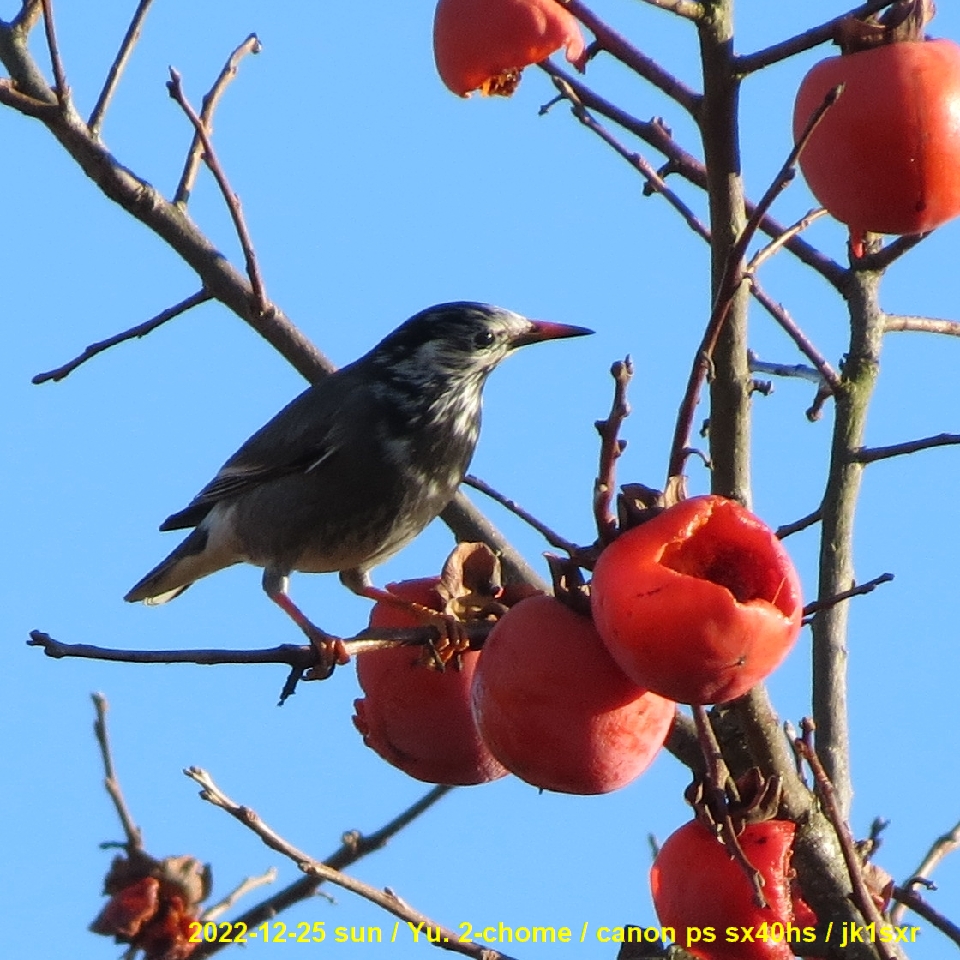 A muku visiting a persimmon. At a nearby field.
A muku visiting a persimmon. At a nearby field.
Muku flocks come to around the station square and make a big fuss in the evening, and recently become a nuisance.
However, they had been highly cherished as they catch a lot of harmful insects.
To leave the persimmon fruits for the muku is said to be a common practice around here from the old days.
653. Pyracantha
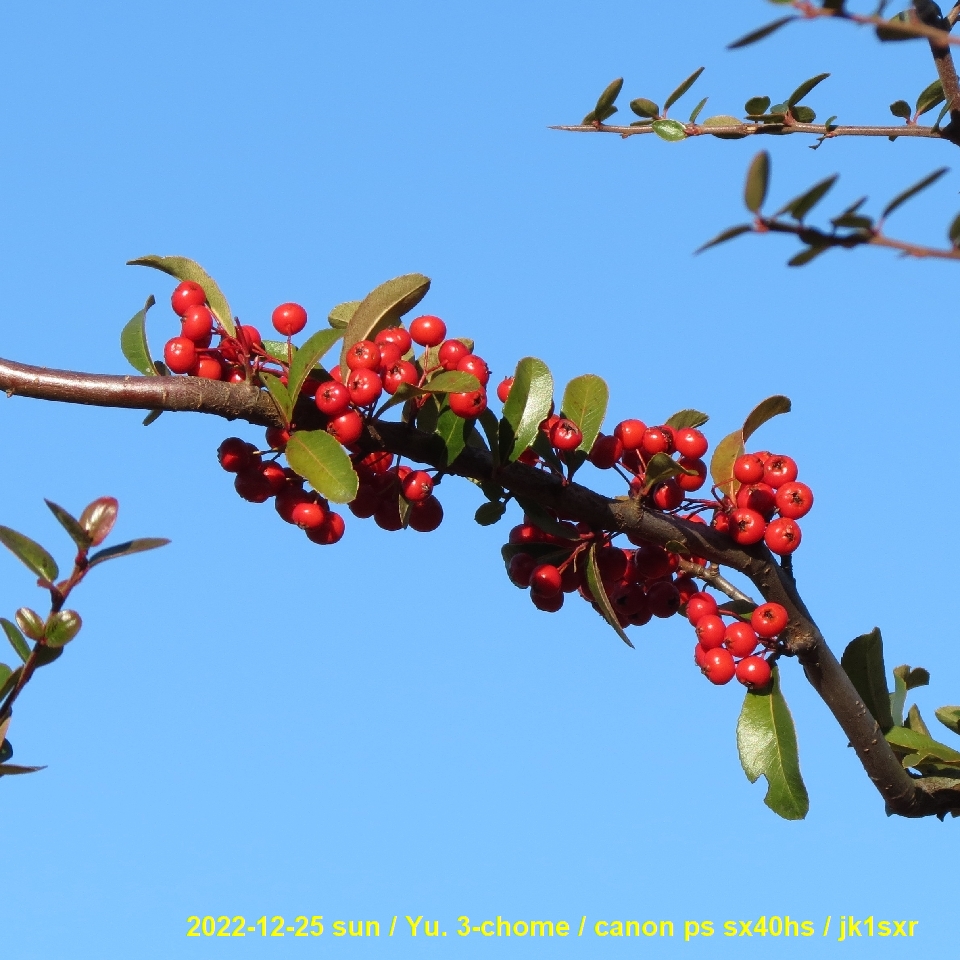 At this time of year, red berries of trees stand out.
At this time of year, red berries of trees stand out.
This is a pyracantha at a nearby vacant lot.
In the past, I frequently saw pyracantha here and there. But not today.
It was at my place too. However I cut down it because its too fast growth and shapr thorns made the proper trimming difficult.
Probably, the number of pyracantha have been decreased everywhere by the same reason.
652. Bear no berries?
Berries of the gin-mokusei tree that produced a lot of white flowers in October at the adjacet square.
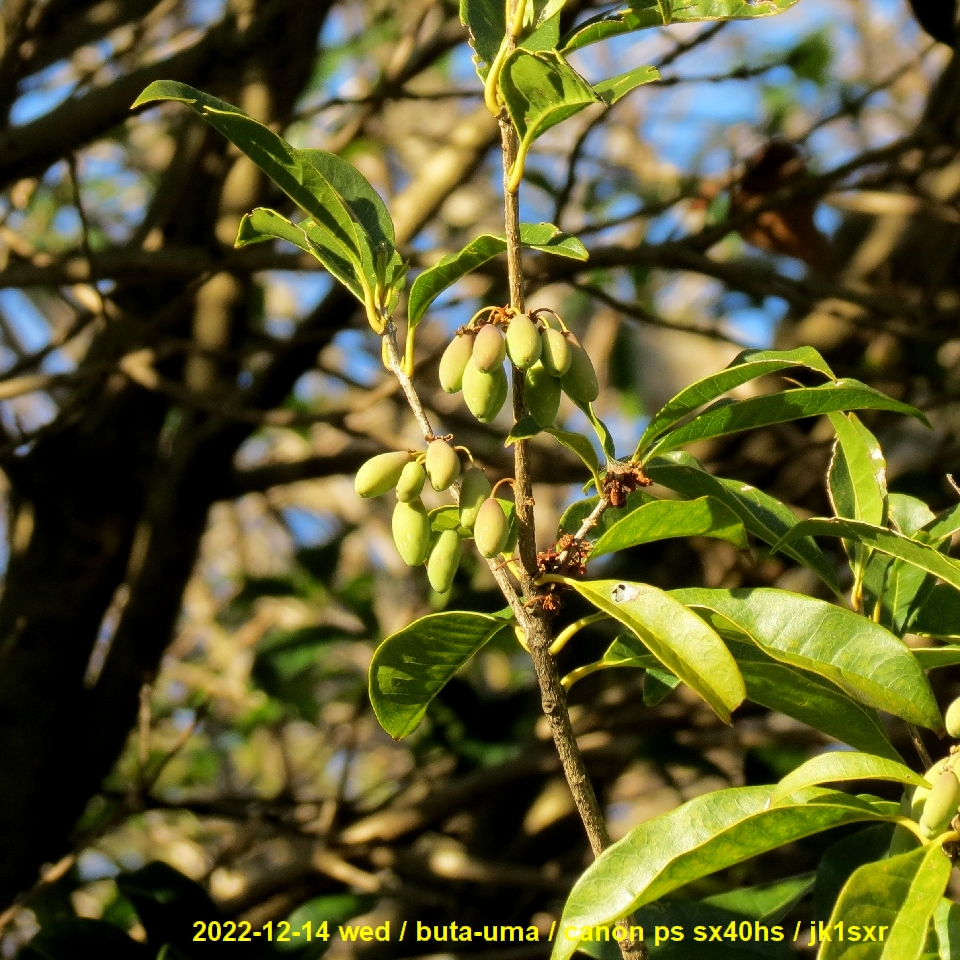 As the trees of mokusei family are dioecious, this is to be a female tree.
As the trees of mokusei family are dioecious, this is to be a female tree.
While, it is generally said that the kin-mokusei which bear orange flowers are said to be all male, and they do not bear berries, even if they produce flowers.
The cited reason is as follows.
"Only the male trees of kin-mokusei were brought into Japan from China mainland during the Edo period, and they have been reproduced by cuttings ever since. Thus the kin-mokusei around us are all male trees."
This is amusing as an episode, but sounds very much strange.
Because, I think that those specialists in botany who can believe they explained this phenomena with that story are not considering the move of our society, i.e., social dynamics, at all.
If the story is true, then many indivisuals or botanical gardens who say "in that case, I or we will bring the female trees here" will surely appear. As the result, such male-tree-only condition can not last long.
It is said that the kin-mokusei's female trees bear much fewer flowers than the male trees. This seems to be the reason for the male-tree-only phenomena.
For example, in the case of the ginko trees that are also dioecious, the female trees bear the berries called gin-nan which emit bad smell. As the people dislike that smell, it is said that those available on the garden plant market are almost all male trees.
IMHO, such is the case also for the kin-mokusei. Namely, the fact is simply that in orde to meet the market demand, only the male trees bearing a lot of flowers have been reproduced by cuttings, and the resulting clones have been distributed on the market ever since the old days until today.
In addition, it is said that the kin-mokusei is a horticultural variant of the gin-mokusei.
Thus the berries of female kin-mokusei must be not so much different from the ones in the photo.
651. What tree's berries?
As the autumn is in full swing, the deciduous tree leaves are almost gone, and the berries hidden behind them become clearly visible.
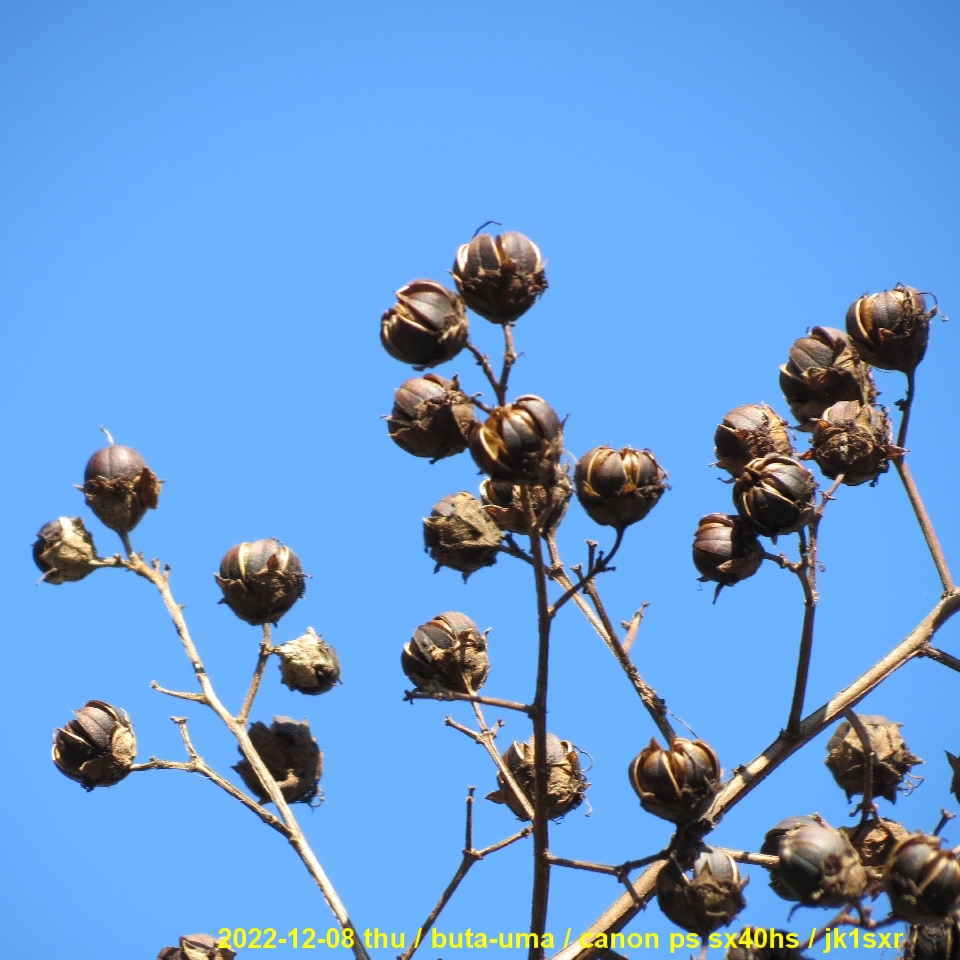 Those who instantly recognize the tree which bears the berries in the photo must be very few.
Those who instantly recognize the tree which bears the berries in the photo must be very few.
These are the berries of sarusuberi tree at a nearby square. (crepe myrtle?)
The matured berry splits open into 6 segments, and fly the winged seeds on the wind.
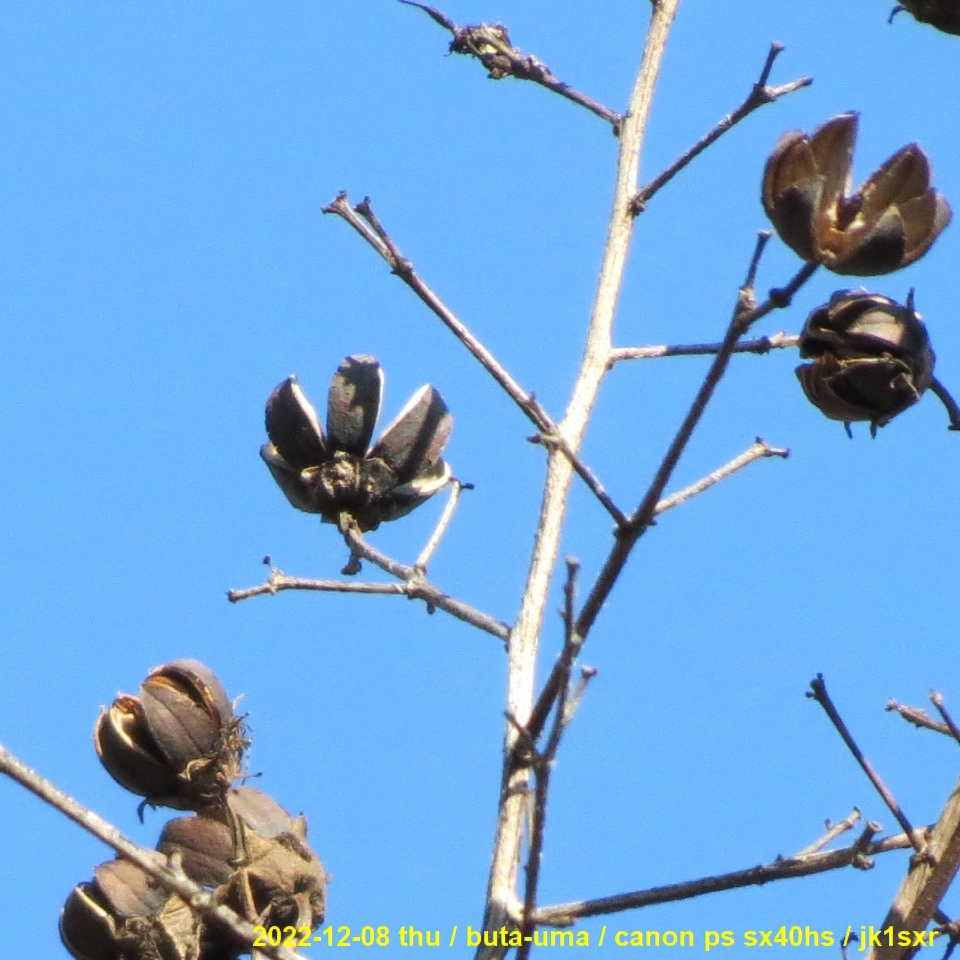 The open berries remain at the branches until spring.
The open berries remain at the branches until spring.
650. Keyaki
Fallen leaves of keyaki tree, picked up at the usual square.
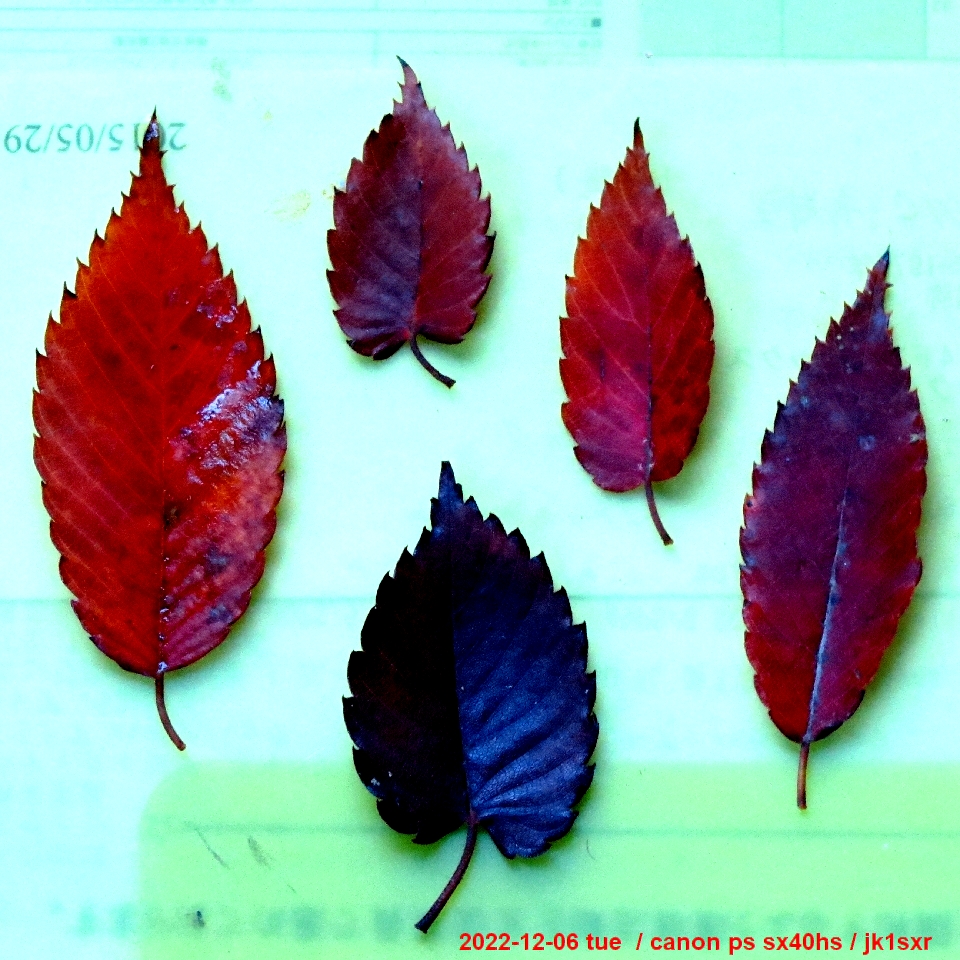 Leaves of a particular tree usually keep the approximately similar figure, even if they are different in size,
Leaves of a particular tree usually keep the approximately similar figure, even if they are different in size,
but it looks keyaki is different.
The keyaki which has been profusely dropping leaves.
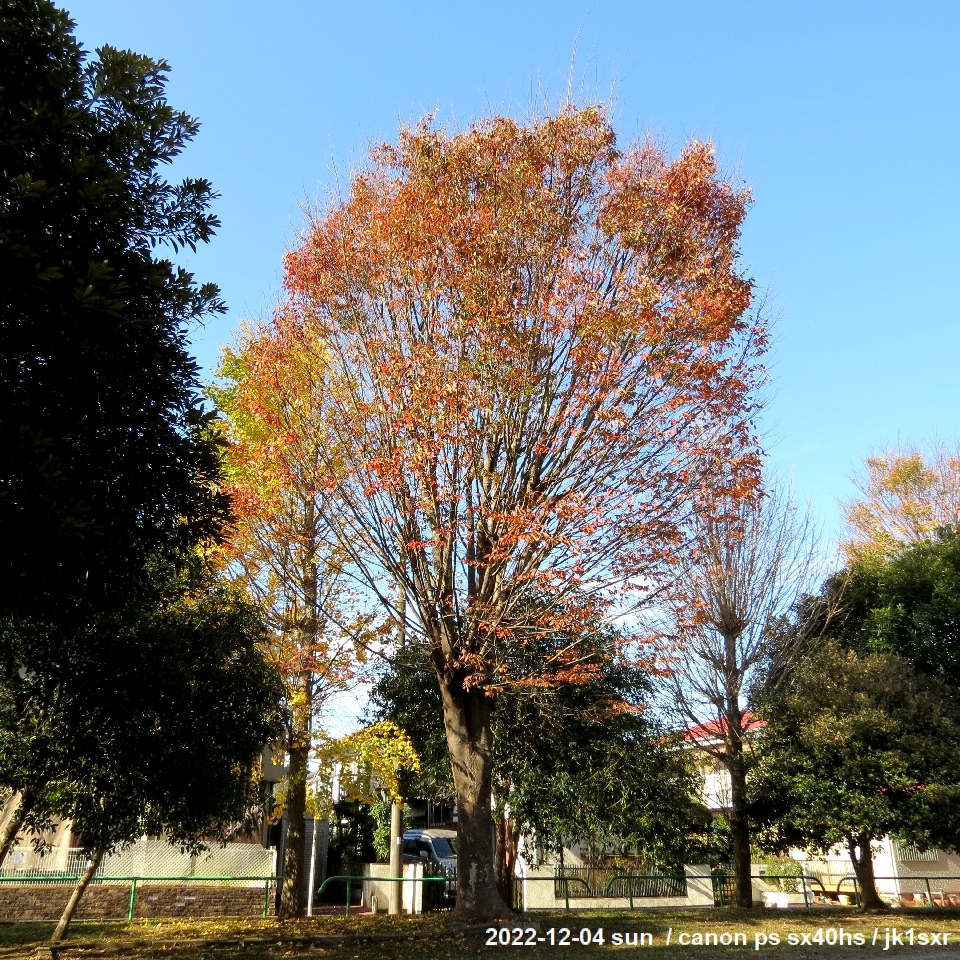
654. Muku
 A muku visiting a persimmon. At a nearby field.
A muku visiting a persimmon. At a nearby field.Muku flocks come to around the station square and make a big fuss in the evening, and recently become a nuisance.
However, they had been highly cherished as they catch a lot of harmful insects.
To leave the persimmon fruits for the muku is said to be a common practice around here from the old days.
653. Pyracantha
 At this time of year, red berries of trees stand out.
At this time of year, red berries of trees stand out.This is a pyracantha at a nearby vacant lot.
In the past, I frequently saw pyracantha here and there. But not today.
It was at my place too. However I cut down it because its too fast growth and shapr thorns made the proper trimming difficult.
Probably, the number of pyracantha have been decreased everywhere by the same reason.
652. Bear no berries?
Berries of the gin-mokusei tree that produced a lot of white flowers in October at the adjacet square.
 As the trees of mokusei family are dioecious, this is to be a female tree.
As the trees of mokusei family are dioecious, this is to be a female tree.While, it is generally said that the kin-mokusei which bear orange flowers are said to be all male, and they do not bear berries, even if they produce flowers.
The cited reason is as follows.
"Only the male trees of kin-mokusei were brought into Japan from China mainland during the Edo period, and they have been reproduced by cuttings ever since. Thus the kin-mokusei around us are all male trees."
This is amusing as an episode, but sounds very much strange.
Because, I think that those specialists in botany who can believe they explained this phenomena with that story are not considering the move of our society, i.e., social dynamics, at all.
If the story is true, then many indivisuals or botanical gardens who say "in that case, I or we will bring the female trees here" will surely appear. As the result, such male-tree-only condition can not last long.
It is said that the kin-mokusei's female trees bear much fewer flowers than the male trees. This seems to be the reason for the male-tree-only phenomena.
For example, in the case of the ginko trees that are also dioecious, the female trees bear the berries called gin-nan which emit bad smell. As the people dislike that smell, it is said that those available on the garden plant market are almost all male trees.
IMHO, such is the case also for the kin-mokusei. Namely, the fact is simply that in orde to meet the market demand, only the male trees bearing a lot of flowers have been reproduced by cuttings, and the resulting clones have been distributed on the market ever since the old days until today.
In addition, it is said that the kin-mokusei is a horticultural variant of the gin-mokusei.
Thus the berries of female kin-mokusei must be not so much different from the ones in the photo.
651. What tree's berries?
As the autumn is in full swing, the deciduous tree leaves are almost gone, and the berries hidden behind them become clearly visible.
 Those who instantly recognize the tree which bears the berries in the photo must be very few.
Those who instantly recognize the tree which bears the berries in the photo must be very few.These are the berries of sarusuberi tree at a nearby square. (crepe myrtle?)
The matured berry splits open into 6 segments, and fly the winged seeds on the wind.
 The open berries remain at the branches until spring.
The open berries remain at the branches until spring.650. Keyaki
Fallen leaves of keyaki tree, picked up at the usual square.
 Leaves of a particular tree usually keep the approximately similar figure, even if they are different in size,
Leaves of a particular tree usually keep the approximately similar figure, even if they are different in size,but it looks keyaki is different.
The keyaki which has been profusely dropping leaves.

Copyright © 2013 JK1SXR/m.abe. All Rights subject to common sense.